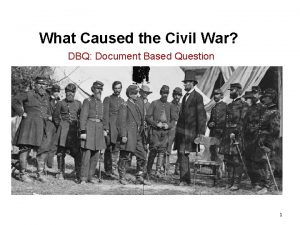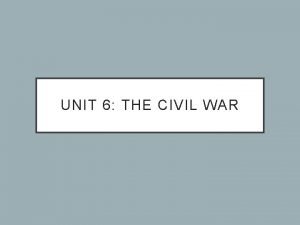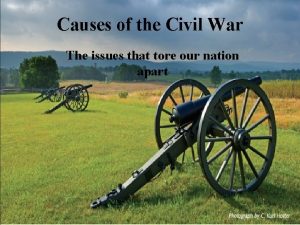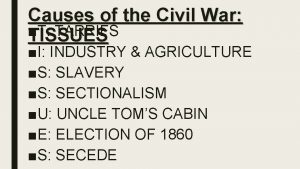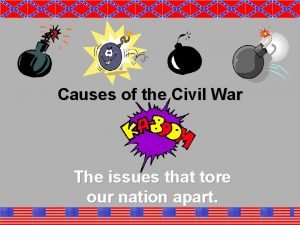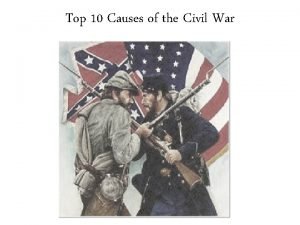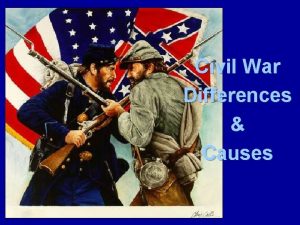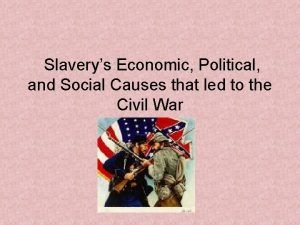Economic Social and Political Causes of the Civil















- Slides: 15

Economic, Social, and Political Causes of the Civil War U. S. Flag 2 nd Official Confederate Flag. It became a problem when there was no wind on the battlefield. Confederate Battle Flag 1 st Confederate Flag: Stars and Bars. It looked to similar to the U. S. flag. 3 rd Official Flag of Confederacy

Economic Causes THE NORTH INDUSTRIAL Farming was not much of an option due to the short growing season, bad terrain, and cold winters. They chose to become industrialized The North was by then firmly established as an industrial society. Labor was needed, but not slave labor. Immigration was encouraged. Immigrants from Europe worked in factories, built the railroads of the North, and settled the West. Very few settled in the South.

Economic Causes SOUTH AGRICULTURAL By 1860 cotton was the chief crop of the South, and it represented 57 percent of all U. S. exports. The profitability of cotton, known as King Cotton, completed the South’s dependence on the plantation system and its essential component, slavery. The South, resisting industrialization, manufactured little. Almost all manufactured goods had to be imported. Southerners therefore opposed high tariffs, or taxes that were placed on imported goods and increased the price of manufactured articles. The manufacturing economy of the North, on the other hand, demanded high tariffs to protect its own products from cheap foreign competition.

Social Causes: Slavery vs Anti. Slavery The South was based on the plantation system while the North was focused on city life. This change in the North meant that society evolved as people of different cultures and classes had to work together. On the other hand, the South continued to hold onto an antiquated social order. NORTH: the North claimed a moral high road, fighting for the release of slaves. SOUTH: Southerners, viewing slaves as "less than a full person", saw nothing wrong with slavery. Therefore, social differences existed as well.

BALANCE OF POWER IN THE SENATE The Missouri Compromise of 1820 It allowed Missouri to enter the Union as a slave state and Maine to enter as a free state. It also prohibited slavery in Missouri over the 36 30 line. Southern members were okay with this because cotton could not be grown profitably over this line anyways. This kept the balance between free and slave states. ██ Union states ██ Union territories ██ Border Union states, permitting slavery ██ Bleeding Kansas, entered Union ██ Confederate states ██ Confederate territories (not always held)

BALANCE OF POWER IN THE SENATE The Compromise of 1850 1. Made California a free state 2. New Mexico and Utah had no restrictions placed on them 3. The slave trade was abolished in Washington DC. 4. A more effective fugitive slave law that would compel local authorities to hunt down runaway slaves for federal officials. 5. A payment of 10 million dollars to Texas to give up the New Mexico Territory. (Texas was a slave state and New Mexico was an unorganized territory at this point.

EXTENSION OF SLAVERY The Kansas-Nebraska Act of 1854 Senator Stephen A. Douglas increased tensions on accident. He wanted to build a transcontinental railroad westward from Chicago. He wanted the land west of the Missouri River to be cleared of Indians and organized into a territory so the railroad could be built. This act eventually repealed the Missouri Compromise of 1820. Kansas and Nebraska were entered as territories. They were both above the 36 30 line so slavery was prohibited there. However, the Act also abolished the Missouri Compromise dividing line. So Missouri, Nebraska, and Kansas were able to form and regulate their domestic institutions in their own way. This caused a race for Kansas by Northerners and Southerners also known as “Bleeding Kansas”. An armed proslavery group burned part of the town of Lawrence, an anti-slavery town. An abolitionist named John Brown gathered an armed group including his own sons and murdered five unarmed pro-slavery men. More than 200 men and women would die before federal troops were called in to restore order.

EXTENSION OF SLAVERY Dred Scott Decision of 1857 A slave by the name of Dred Scott sued for his freedom. His master had died and he lived in a free territory for 5 years. The court ruled that (1) slaves are not citizens so they could not sue in state or federal court and (2) slaveholders can take their property into any territory without restrictions.

ROLE OF ABOLITIONISTS Harper’s Ferry 1859 John Brown believed that God visited him and told him to free the slaves. He decided to seize a federal arsenal in Virginia, arm the nearby slaves, and lead the slaves in a rebellion. However, no slaves joined him. He was captured by Colonel Robert E. Lee and he was tried and hung. Northern abolitionists saw him as a martyr and Southerners saw him as a lunatic.

ROLE OF ABOLITIONISTS Frederick Douglass – He was a slave who escaped his master and became involved in the abolitionist movement. – He joined the American Anti. Slavery Society and subscribed to THE LIBERATOR, which was an abolitionist newspaper. He would later write for this paper and make speeches against slavery. William Lloyd Garrison – Was the leader of the American Anti-Slavery Society and founder of THE LIBERATOR.

ROLE OF ABOLITIONISTS Harriet Tubman – She was an African-American abolitionist. As an escaped slave, she made nineteen missions to rescue 300 enslaved people to freedom in Canada using the Underground Railroad. Harriet Beecher Stowe – was an American abolitionist and novelist, whose Uncle Tom's Cabin (1852) attacked the cruelty of slavery. It made the political issues of the 1850 s regarding slavery tangible to millions, energizing anti-slavery forces in the North. It angered and embittered the South.

POPULAR SOVEREIGNTY VS STATE RIGHTS The idea that the central government has the right to control decisions vs state rights which state that these states can make whatever rules they want. In the Civil War, this issue was focused around the concept of slavery. The Southern states felt it was their right to make the decision of the legality of slavery while the north believed the federal government had the power to make rules stick to ALL states.

PRESIDENTIAL ELECTION OF 1860 There were four political parties fighting for control in the election. One party was called the Constitutional Union Party. Their candidate was John Bell. This party’s platform was to basically live by the Constitution. The Democrats had two candidates, John C. Breckenridge and Stephen A. Douglas. The Republicans had one candidate, Abraham Lincoln. The various candidates split the South’s vote. Lincoln won, but by a minority of the votes. He had 40%. Douglas had 29%. Breckenridge, 18% and Bell 13%.

Secession This was the last straw for the South. Shortly after the election, the state of South Carolina called a special Convention to consider secession as an option. South Carolina was the first to secede followed by Mississippi, Florida, Alabama, Georgia, Louisiana, and Texas. They drafted a new Constitution and gave themselves a name: The Confederate States of America. The Constitution was similar but it had some major differences. One was that the states were sovereign and independent from each other and it guaranteed the right to own slaves. There was no judicial system and the president served for one six year term with no reelection.

Fort Sumter Five days after South Carolina declared its secession, a U. S. military major and his 2 companies occupied Sumter in the hope that because it had good defenses, it would delay a Rebel attack. Over the next few months, repeated calls for Union surrender from Confederate Brigadier General P. G. T. Beauregard were ignored, and Union attempts to resupply and reinforce the garrison were rebuffed. On April 12, 1861, at 4: 30 a. m. , Confederate batteries opened fire, firing for 34 straight hours, on the fort. On April 13, the fort surrendered and was evacuated. No Union soldiers died.
 The physical container or wrapping for a product.
The physical container or wrapping for a product. Forces behind management thoughts
Forces behind management thoughts Political economic
Political economic Civil rights and civil liberties webquest
Civil rights and civil liberties webquest Puritans england
Puritans england Chapter 3 political and economic analysis
Chapter 3 political and economic analysis Chapter 3 political and economic analysis
Chapter 3 political and economic analysis What caused the civil war dbq
What caused the civil war dbq Causes of the civil war
Causes of the civil war Causes of the civil war jeopardy
Causes of the civil war jeopardy What were the 4 main causes of the civil war
What were the 4 main causes of the civil war Tissues causes of civil war
Tissues causes of civil war What are the 3 main causes of the civil war
What are the 3 main causes of the civil war Causes of the civil war
Causes of the civil war Cause of english civil war
Cause of english civil war What is economic growth and development
What is economic growth and development







